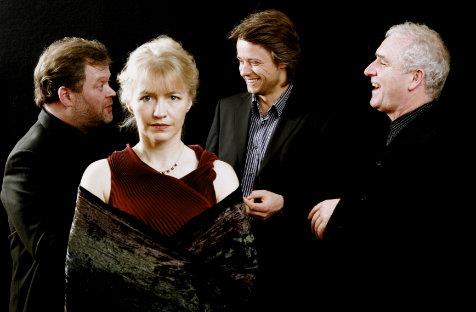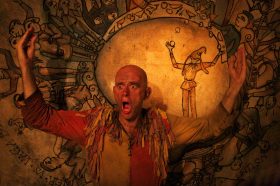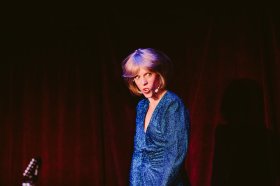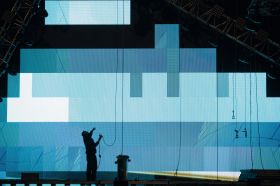The Australian National Academy of Music (ANAM) has done it again! We have come to expect something very special each year from this exceptional Australian music institution and the highlight of 2013 is its collaboration with the Brodsky Quartet, playing all 15 of Shostakovich’s string quartets. As part of their 40th anniversary celebrations last year, the quartet decided to revisit Shostakovich’s extraordinary quartet legacy, which is well and truly in their musical souls. The students of ANAM are the fortunate beneficiaries. Not only were they able to hear the quartets as a whole, with several being played by international musicians at the top of their game in terms of technique and artistry, but they were able to play with these artists, thus gaining insights that would be impossible to achieve with master classes alone.
The first program started with a bang in the most literal sense. South Melbourne Town Hall is far from soundproof and a fairly continuous stream of fireworks punctuated the first movement of Shostakovich’s first string quartet. Three ANAM students were joined by Faculty member, Caroline Henbest, whose warm viola did much to guide the sometimes tentative students through a creditable reading of the quartet. If the students needed practice with dealing with performance nerves, then this stressful occasion certainly provided the opportunity. Nevertheless, by the end of the quartet, they had relaxed enough to engage more fully with the music and convey the joie de vivre of the final Allegro.
Quartet 11 was given a much more confident performance. This time the ANAM musicians were joined by Ian Belton, the second violin of the Brodsky Quartet. This seemed to be an ideal partnership as Courtney Cleary strove to integrate her musical sensibility with Cleary’s. All three ANAM musicians showed technical skill and an ability to capture the shifting character of emotional content. A striking example of the astonishing range of colour that Shostakovich’s work calls for was Belton’s uncanny muted horn sound in the Adagio. All musicians dedicated themselves to expressing the passion and beauty of the work at all times.
There might have been explosive thunder during the opening quartet, but it was after interval that lightning really struck. Much of String Quartet No 2 features the first violin and Daniel Rowland was the lightning rod. He is a super-charged performer, whose every bow stroke is infused with an electric passion. This quartet calls for great virtuosity and flair from the first violin and Daniel Rowland has both. Joining the Brodsky Quartet in 2007, he was described by Ian Belton as ‘a shot of adrenalin’. Those in the audience who subscribed to the series believing that all 15 quartets were to be played by the Brodsky Quartet should have gone home more than satisfied. In this and the other four works in which they played as a quartet (one per concert), the musicians displayed a unity of purpose and sound that is expected of the finest quartets. The ‘animal with four heads’ breathed as one with each head exhibiting its own brand of individual excellence. Often, Shostakovich scores sections of his quartets for two voices in conversation; the same kind of organic mutual understanding was apparent here.
Of course, the danger in a project that mixes top-ranking professionals with student musicians is that the students will appear comparatively pale and inept. By and large their instruments are considerably inferior and they lack the wealth of experience and maturity that hones talent. The biggest test would come when they were pitted against the formidable Daniel Rowland in the third session for Quartet No. 5. In the event, it came as no real surprise that, in a generous acknowledgement of the quality of the ANAM students he said in a talk before the concerts on the final day, ‘They kept me on my toes’ and, before the final item on Sunday night, ‘It was an inspiration to work to work with these world-class students’. Among the many revelations of the series was the way Yena Choi, Katie Yap and Jack Bailey went from strength to strength in a true musical collaboration with Rowland.
Other special moments of collaboration came as Paul Cassidy guided the ANAM musicians through Quartet No. 13, dedicated to the Beethoven Quartet’s violist, Vadim Borisovsky. Although sometimes overly cautious, the careful chording of important passages was satisfyingly spot on. Jacqueline Thomas, a cellist of great warmth, sensitivity and refinement guided Madeleine Jevons, Ioana Tache and Anthony Chataway through a confident and very beautiful reading of Quartet No. 14. The way the four voices were able to follow each other in the helter skelter of the final allegretto was a miracle of dovetailing and indicated the intensive preparation that had gone on before the arrival of the Brodsky Quartet.
Among the many standing ovations, possibly the most heartfelt audience response came on the last day. After the No. 14, the Brodsky Quartet gave a deeply moving performance of Shostakovich’s final quartet, written as he was close to death. Daniel Rowland had said in his preceding talk that he had only played this series of elegies at night. In contrast, rather than the atmospherics of subdued lighting, the afternoon sun streaming through the windows gave a special radiance to the beginning of the quartet. Then the clouds gathered and the South Melbourne clock tolled its four notes towards the end of this mystical piece in an eerie evocation of Shostakovich’s four-note signature – not to mention the knocking of Fate. At the end, the audience sat stunned, many close to tears, absorbing an extraordinary experience.
The most vocal ovation was given to the ANAM musicians performing Quartet No.9. Admittedly, this quartet is something of a showstopper anyway, but the display of skill and the energy generated were unbelievably exciting. Most of the quartets had either a Brodsky or Faculty member or an alumnus to guide them, but Caroline Hopson, Nicholas Waters, William Clark and Mee Na Lojewski rose to the occasion magnificently as a quartet of very fine ANAM musicians.
The choice of Rudolf Barshai’s transcription of Quartet No. 8 was the perfect ending for the series as the Brodsky Quartet were joined by all of the ANAM strings. With the Brodsky strings on the solo sections and Amy Brookman leading the tutti passages, Shostakovich’s most personal work, dedicated to the victims of fascism and war, was given a passionate realization. It would be hard to find a more powerful viola section anywhere. Although this version might lack the desolation of the original, the power generated in this performance was absolutely convincing.
For many members of the audience this will have been their ‘Ring Cycle’, where exceptional musicians breathe vibrant life into works by a composer of genius. It takes an institution such as ANAM to bring important collaborations such as these to fruition. Jacqueline Thomas pointed out in her pre-concert talk that, as school children, members the Brodsky Quartet benefitted from a political climate of musical support that can now be seen in Venezuela’s ‘systema’. In turn the world has benefitted. It is crucial that the politicians of Australia continue to support institutions such as ANAM and even further their efforts to ensure that Australia’s musical talent is nurtured from an early age. In this way, Australian society will be the richer. Viva ANAM and those politicians and philanthropists who believe in the value of music!
Rating: 4 ½ stars out of 5
Australian National Academy of Music
The Brodsky Quartet & ANAM Musicians
Shostakovich String Quartets
South Melbourne Town Hall
5 July: Quartets 1, 11 & 2
6 July 5pm Quartets 6, 13 & 3
6 July 8pm Quartets 7, 5 & 12
7 July 2pm Quartets 10, 14 & 15
7 July 5pm Quartets 4, 9 & 8





